|
|
|
||||||||||||||||||||
|
|||||||||||||||||||||||
|
Last February 27th it was presented in Barcelona the book "Gaudí a la Vall de Lillet". . In the luxurious art nouveau atmosphere of the Circulo del Liceo, the curator of the Royal Gaudi Chair and co-author of the book, Joan Bassegoda, remarked the great admiration and respect that the architect had towards nature. The luxuriating design of a garden is integrated in the natural environment, creating an idíllic space where minute details are transformed into great genialities in the valley irrigated by the river Llobregat. Fotographs: Joan Ribera
. |
Artigas Garden of Pobla de Lillet Only surpassed by Barcelona, la Pobla de Lillet, a small village in the heart of Catalonia, it occupies the second place in possessing more works by Gaudí. With the occasion of the recent presentation of the book "GAUDÍ A LA VALL DE LILLET", we offer you a virtual visit to these magnificient gardens, designed by Gaudí in 1903, under request of Joan Artigas Alart. Like his architectural works, Gaudí designed this garden being based in the natural structures and forms and achieved a symbiosis between architecture and nature. In the 1903 Spring, when Gaudí had already started the Park Güell works, the textile manufacturer Joan Artigas commissioned him the design of a garden in his terrain measuring 4 hectares that enclosed part of the high course of the Llobregat river. Because of the geographical location of the garden, this reamained unnoticed till 1971, when R. Bonamusa, a correspondent of the newspaper "El Correo Catalán" discovered its existance after talking with a bricklayer who had worked there in his youth. The reference to the Vall de Lillet did not arise interest till sometime afterwards, thanks to the reproduction of the garden plans by a student of the Royal Gaudí Chair. Gaudí designed this garden but he did not direct the works personally; he sent to the Vall de Lillet a bricklayer of the Park Güell, who built the grotto sited close the entrance. The rest of the works were done by the entrepreneur firm owned by Juan Riu, who followed the plans and designs by Gaudí. The architect only took two days to inspect the terrain prior to conceive then the garden. It may be established a parallel between the Artigas Garden and the Park Güell, although there exist many differences among them. The most important: water. Whereas the park of Barcelona is dry, in the Vall de Lillet the protagonist is the river, that draws and determines the entourage and the vegetation. The garden has balustrades, bridges and gazebos so as to admire the ceaseless water flowing. Facing the happy "trencadís" colouring in the Park Güell, the Artigas garden prefers the stone and the natural green of trees and bushes. Finally, it must be remarked
the always existing symbology in the gaudinist work. On this occasion,
four stone sculptures -a bull, a lion, an eagle and an a presently
vanished angel-, placed forming a cross, depict the four evangelists. |
|
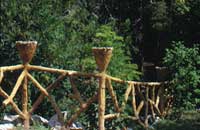 |
The fact that the Artigas Garden have changed from being a private space to a public one has alterd considerably its access. If, to visit them, you had formerly to go to the factory porter's office and to ask for the key of the access gate that existed (and still does) at the end of a narrow street in the middle of industrial buildings, now the access is just through the opposite side. It is recommended, however, to do the visit following the historical route, because it becomes altogether the chronological building route of the work and an ideal way conceived to discover the several elements of the Garden following a logical and balanced sequence, but, also, surprising. | |
 |
The Garden is articulated on both banks of the Llobregat river. Initially, the only public access to the Artigas Garden was through a bridge that spans over the Llobregat, just in the other side of which it is found at once the Magnèsia fountain grotto. This artificial cave, measuring 6 by 2 metres, was built out of great blocks of rough stones, and it has two hollowings or windows, with winding benches under the parapets, that allow to gaze how the river water spring joyfully. It's in this grotto where the spirit of Gaudí may be clearly breathed, not only because of the shapes, but also because of the stone treatment. Just over it there are some steps that lead to the rough pergola inside of which there is the Lion fountain, with a sculpture that, like the rest ones in the Garden when the restoration was enterprised, were made by Ramon Millet i Domènech, a member of the Royal Catalan Academy of Fine Arts of Saint George. It is also possible to reach the pergola by means of a staircase at the right side of the entrance bridge, just before entering the grotto. There is immediately a path flanked by boxes with a pitch zone that reaches, on the left side, till the balustrades over the river cliff, a railing made of river peebles over reinforced concrete. On the other side, at the left of the path, under the cliff capped by the train rails that went from Guardiola de Berguedà to the Clot del Moro, there is a pine forest at the bottom of it the Ox fountain is found. | |
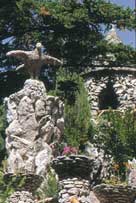 |
Just beside, on the left hand, presided by two tall flowerpots, there is the springing arch bridge, called the Magnèsia bridge, that holds the stair that permits to reach the big cedar at the foot of which there is the Eagle sculpture with deployed wings, also made of tiny stones | |
|
A staircase, at he right
hand, allows to reach the circular-planned pavillion with conical
roof, called the Glorieta, that enables an excellent view of the river
and the Garden ensemble. It is built, like the rest of the Garden,
with rough stone coming from irregular lime deposits. |
||
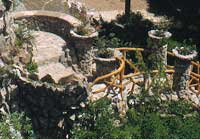 |
Coming from the gazebo and retaking the route by means of another bridge flanked by interlaced snake- shaped flowerpots, we reach the upper walk that, at left, leads to another gazebo. There is also from this point a very good view of the Garden ensemble. At right starts the path that runs parallel to the canal that supplies water to the factory from a dam placed upstream. Before reaching the gazebo there is a draining canal that once formed a very showy artificial cascade, especially when seen from the other side of the Garden. In the path leading the dam there still are, excavated in the cliff, some ancient lime kilns. |
|
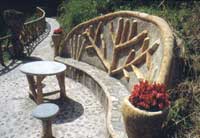 |
Before reaching those kilns, at right, there is a path that, with narrow radius curves, that crosses the disbalance and leads to a small square where benches attached to the wall and a table that was used as a picnic spot. | |
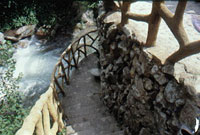 |
Parting from this point, at left, we will find the steps that lead till the balcony placed over the river Llobregat, a spot with a nice view of the crystalline waters, surrounded by an exuberant vegetation. Climbing back to the tiny square, one enters the so-called pont dels Arcs (Arches bridge), at its entrace there two human shaped flowerpots: a man and a woman, also the work of the sculptor Millet. |
|
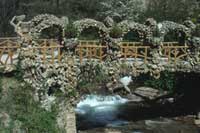 |
The bridge is depressed arch shaped with rustic railings and five arches equally made out of rough stones. The bridge permits to come back to the left bank of the river and to regain the even zone, where splendid poplars grow. There is a paving over the grass, the path flanked by box bushes and a circular square where, surrounded by plane trees, there is a palm tree. Glycines, yuccas and other plants not authoctonous from the Berguedà were brought from the Park Güell, by Gaudí's will. On the train cliff side there is a big cascade made out of rough stones, with holes, where water flows and moss grows. After the Palm tree square the boxwood bushes path goes on till the bridge leading to the Tempietto and the walk is over. |
|
|